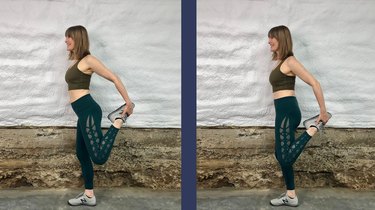
Picture this: You crush leg day, only to wake up the next morning unable to walk down the stairs or squat to use the toilet.
If you've felt this dreaded post-workout soreness, you know how important it is to include moves like the standing quad stretch during your cooldown and recovery days, especially if the soreness settles in the front of your legs (aka quads).
Video of the Day
Video of the Day
And while this old-school stretch is one worth keeping in your line-up, there's one tiny adjustment you should make so that this move way is more effective and provides some much-needed relief for your sore muscles.
How to Do the Standing Quad Stretch Properly
So, what is this tiny adjustment? Holly Perkins, CSCS, the author of Lift to Get Lean, cues her clients to tuck their pelvis when doing the standing quad stretch when the traditional stretch isn't enough.
Standing Quad Stretch

- Stand near a stable object like a table, wall or chair that you can use for balance if needed. You can also do this stretch unassisted.
- Bring your left heel back behind you as if you were going to kick yourself in the butt. Hold your ankle, foot or pant cuff with your left hand. Keep your right knee slightly bent, not locked.
- Tuck your pelvis under (this may cause your left knee to move forward in space) and squeeze your glutes.
- Holding this pelvic tuck, draw your left knee back in space so that it's directly next to or behind your right knee (the standing leg).
- Hold this position for 30 seconds or longer.
- Switch legs and repeat.
Tip
As a static stretch, the purpose is to hold a position for a specified period of time, which helps loosen the muscle, decrease stiffness and increase flexibility and range of motion.
That means stretches like the standing quad stretch work best at the end of a workout when your muscles are warm and you’re ready to cool down. Aim to stretch each leg 2 to 3 times, holding for 30 seconds or longer.
Why Quad Stretch Adjustment Works
You might be wondering why you should give this version a try when you've been doing the traditional stretch for years. To understand why this tweak works, we first need to review a bit of hip and leg anatomy.
The quadriceps attach above the hip joint and insert below the knee joint. In order to fully lengthen the muscle from end to end, Perkins says it's important to open the associated joints as well.
"By tucking your pelvis, you open the front of your hips, therefore lengthening the upper portion of the quadriceps," she says. Then, when you draw your knee back in space, you're providing a greater stretch to the muscles as you increase the distance between the two anchor points of the quadriceps (the hip and the knee), she says.
In addition to this tiny adjustment, for the quad stretch to be effective, Perkins says you also need to understand the nature of stretching.
"Due to the stretch reflex, it's important to 'listen' to your muscles as you are stretching them," she says. "Over-stretching causes the potential for recoiling of the muscle and therefore limits the lengthening."
As you move into position, Perkins says you should feel a mild stretch in the intended muscle — in this case, the quadriceps. This sensation should ease up over the first few seconds you're holding the stretch, but if the stretch intensifies, Perkins says to ease off of your positioning a bit until the stretch feels mild and relaxing.